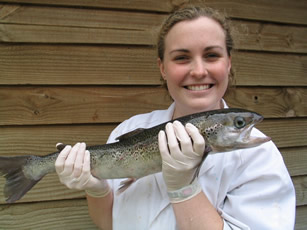
| Home > The Scientists > Renee Florent | |||||||||||||||||
There are two main approaches to using treatment agents: either bath or oral administration. There are numerous advantages in using oral preparations including: the lesser quantity of active substance released into the environment compared to bath treatment, it is less stressful to the fish, and oral treatment is relatively non-hazardous to the farmer. However, with oral treatments there can be problems including but not limited to: reduced palatability of the feed due to incorporation of the agent, dosage rates can be difficult to standardise as not all fish will eat the same amount of feed, and there is a risk that fish will not eat the medicated feed due to the effect of the disease itself on appetite. The oral treatments that Renee is examining would however be cheaper and less time consuming than the current management techniques. Renee is able to conduct this research and undertake her PhD with the scholarship, funding and facilities obtained through the Aquafin CRC, University of Tasmania, and the Society of Experimental Biology. With financial support, Renee has been able to make an oral presentation at the Fisheries Research and Development Corporation Aquatic Animal Health Conference in Cairns and next month has the opportunity to present at the European Association of Fish Pathologists Conference held in Copenhagen, Denmark.
For more information and great ideas for classroom activities, visit: Aquafin CRC School of Aquaculture CSIRO Marine
Research
When Renee worked at Seahorse World at Beauty Point in Tasmania’s north, one of her responsibilities was to feed the seahorses. Seahorses feed primarily on crustaceans, and one of these crustaceans is shrimp. In captivity, such as aquariums, the most common food offered to seahorses is brine shrimp, and it is possible for you to grow your own brine shrimp at home or at school. Brine shrimp are small creatures, but are visible to the eye, measuring in at maximum length at 1.3cm. Brine shrimp do not live in the ocean, but they are adapted to salty water, living in salty inland lakes around the world. Brine shrimp can live in water having several times the salinity of seawater, however they can also live in water much less salty than seawater. Kits to grow brine shrimp, also known as Sea-Monkeys can be purchased with full instructions at many toy stores and pet shops for approximately $20. You do not even need to have an aquarium or salt water, as the kit comes with a miniature aquarium, and only tap water is required. You will be able to watch the brine shrimp grow as you feed them, identify the males from the females, and once they are old enough watch them breed to produce more brine shrimp. Your students can even do experiments to determine how environmental conditions affect the ability of brine shrimp to hatch and develop.
This web site
gives suggestions for scientific experiments that can be done with
brine shrimp. Experiments can determine how different factors (e.g.
temperature, salt concentration, light) affect the hatching and
development of brine shrimp. If your class
is feeling adventurous you could even look at having a seahorse
aquarium in your classroom, and feeding the seahorse the brine shrimp
you have grown. Please note that seahorses will need to be feed
more than just the brine shrimp, as brine shrimp alone do not provide
enough nutritional value to the sea horse. For instructions on setting
up a sea horse tank in your classroom, please there are some good
websites to visit: If you would
like advice on setting up a seahorse tank from Tasmanian experts,
and would like somewhere to purchase the seahorses and food, please
visit the Seahorse World website: For more information
on brine shrimp: |
|||||||||||||||||



